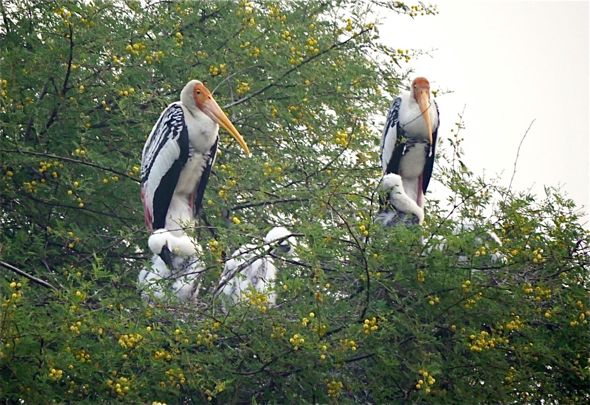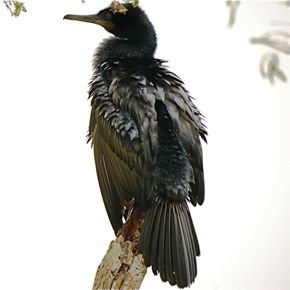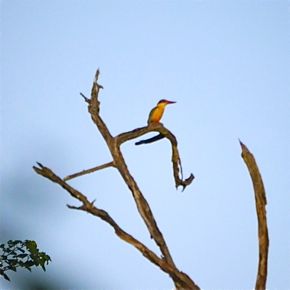“I let the wife choose the destination for the trip to celebrate our 20th wedding anniversary. We wanted a little luxury. So although we are both nature lovers, that ruled out trips to see polar bears or gorillas in the wild, even though it would have been nice to catch up with close relatives. Those tours involved carrying backpacks, rowing inflatable boats and helping with housekeeping chores. They appeared too much like a cross between preparing for an expedition and reporting for military reservist training.
“We were seduced by the luxurious images on the official website of the Palace on Wheels. The carriages of this luxury train were supposed to be replicas of those used by the Maharajas in a bygone era.
“We booked our trip, and at Delhi station, the Palace on Wheels rolled in (above and below).
“Suffice to say that we paid five-star prices for what I consider three-star facilities. We would start each day with a visit to famous temple, then go on to an impregnable fort, within which was a luxurious palace, where a virtuous and beautiful queen once lived with her brave husband who valiantly defended her against an evil invader.
“And next day we would visit a famous temple, then go on to an impregnable fort —and so on for a whole week. The names and places changed, but the story was repeated at every train stop, where at the end of each day we would be shepherded to the local handicraft centre where we were expected to show some more support for the Indian economy.
“Desperately trying to escape ennui, I often wandered off, and found bird-watching bonuses. And the program did offer two welcome breaks from the set routine.
“In India, people are much more tolerant of birds and animals than in many other countries. Even within the cities there was wildlife to photograph (below).
“And although there were thousands of people thronging the grounds of tourist attractions, they did not disturb the wildlife. Egrets foraged undisturbed on the lawns of the Taj Mahal (below).
“I must apologise that this account does not much more than list the birds I encountered.
“Even though I carried only the equipment you would expect of the average tourist, fortunately, my zoom lens extended up to 400 mm (35mm format equivalent).
“The almost constant fog (or was it smog?) did nothing to add to the quality of the pictures. But luckily, digital camera software today allows for auto-correction – which helped to some degree. Many of the birds were too small, or too far away, to register properly on my camera’s autofocus. Often, I just had to click the shutter and hope for the best.
“And the species identifications could be downright wrong. I know hardly anything about Indian birds, and just put down the names that the natives told me. Any corrections or comments from readers would be welcome.
“The species encountered most often was the Indian Babbler, Turdoides striata (above left). It could be found in gardens, forests, and farmlands and seemed to fill the roles that the Common Mynah, Acridores tristis, or the Javan Mynah Acridores javanicus perform in Singapore. The former is also found in India. Though I did see a few, they were anything but common.
“Another member of the Starling family that I did encounter was the Rosy Pastor, Sturnus roseus (above right). The birds in the photo are in their duller winter plumage. They probably migrated down from Central Asia to spend the cold months in India. Unlike its relatives (which may be disowned, since there are suggestions that it should be moved out of Sturnus into a separate genus) the Rosy Pastor is not a bird of the cities. I did not encounter any except in the jungles.
“Ancient Indian rulers were as obsessed with water security as the Singapore Government. They understood that their impregnable forts would not remain so for long if the troops had nothing to drink. Every fortress that I visited, even those built on hill tops, had a large rainwater catchment tank.
“Though it looks like a duck, I suspect it is a Little Grebe Tachybaptus ruficollis (above left). He commandeered a tank in Rajasthan as his private fishing pond. For almost an hour he dived and dipped with great success, coming up with a good catch. Some of the fish, like the one in the picture, were too big for him to swallow at one gulp, and he had to spend time manipulating them in his beak before they could go down.
“And our official program did give us a short trip in the Keoladeo Ghana Bird Sanctuary near Bharatpur. This wetland habitat is supposed to house hundreds of species. No motorised vehicles are allowed inside. Tourists are ferried in pedicabs and the knowledgeable guides move around on bicycles. There was lots to see in the less than two hours that we spent there.
“Indian Snake Birds, Anhinga melanogaster, were plentiful (above right).
“Some cruised in the water with only their heads and necks exposed, looking very much like their namesakes. Others, like the one above, spread their wings to warm in the sunlight before diving again into the chilly waters.
“Herons were also a common sight. I could not positively identify the species to which this one belonged (above). Any suggestions?
“Other water birds included Black-headed Ibises Threskiornis melanocephalus (above), with Painted Storks Mycteria leucocephala also in the picture. The storks are resident in India, where there is a breeding population. This pair is tending three youngsters (below).
“Another large wader present in this Bird Sanctuary is the Black-necked Stork, Ephippiorhynchus asiaticus. (below left).
“Indian Cormorants, Phalcocorax fuscicollis, were present not only in the reserve, but also could be found around the water tanks and ponds at various forts and temples (above right).
“Some of the birds that I saw, but did not take pictures of, could have been Little Black Cormorants, Microcorba nigra. The range of this species extends into India. But I feel that the bird in the picture is the Indian Cormorant, because, although dark in colour, it is not quite black. And its bill ends in a hook, whereas that of the Little Black Cormorant (which I have photographed in Australia) is pointed.
“The Stork-billed Kingfisher, Pelargopsis capensis, was common in the nature reserves (left). But like most kingfishers, it would not allow a close approach. This one was photographed at the limit of my telephoto lens. Our familiar White-breasted Kingfisher, Halcyon smyrnensis, was even more common, and could be encountered everywhere in the countryside. But again, it was not easy to photograph.”
Lee Chiu San
Singapore
21st January 2013
…to be continued.























5 Responses
I agree with you that the Indians are particularly tolerant to animals, perhaps it has to do with religion. There were plenty of rose-ringed parakeets in Delhi and Agra creating a lot of noise in Taj Mahal compound. wonder if you have noticed. The heron in your picture is one that i had encountered a few times in India, it is a Indian Pond Heron I think.
The common babbler we see in Northern India is probably the Jungle Babbler. I cannot see any obvious differences between them and the Yellow-billed Babbler of Sri Lanka, but they are apparently different as stated in birding literature.
The mystery heron above is Indian Pond-Heron. I just returned from India myself, they’re found at nearly every body of water, large or small.
Thank you for the identification Nate.
Hi Chiua San and Innez,
Hope to make contact with you soon re. our possible trip to Singapore June 2014.
Let me have you up to date email and I will send you a long message. Tried on your old email and it got bounced back. All is well here. Busy and in good health.
Fondest regards
jack and Rita.